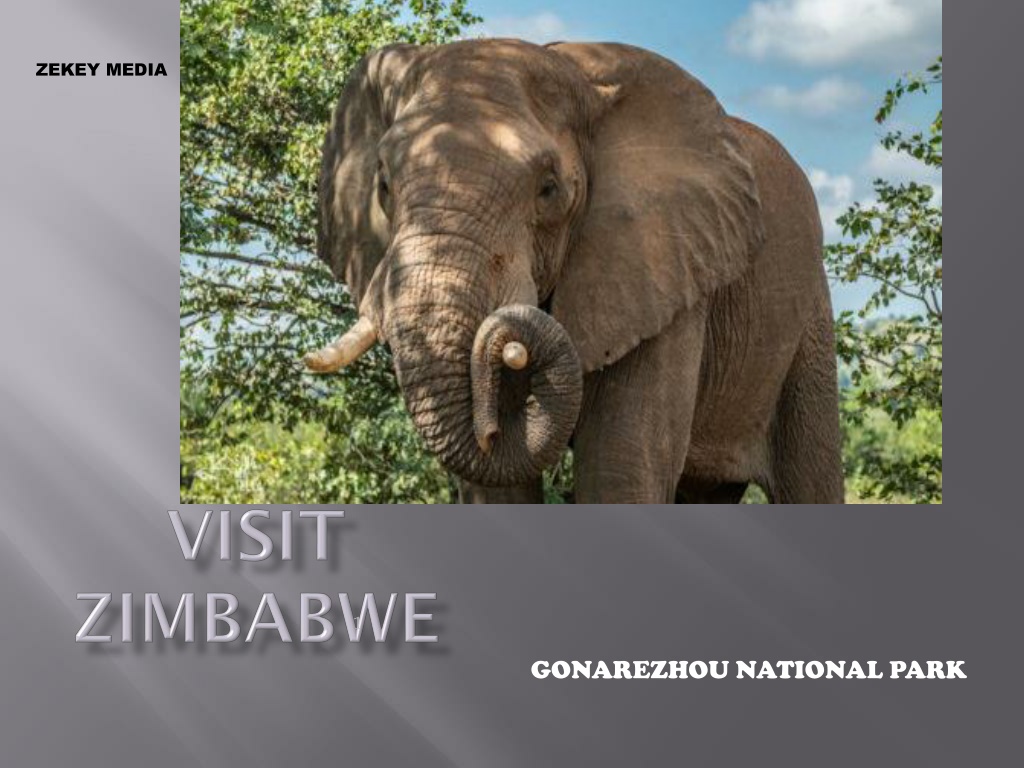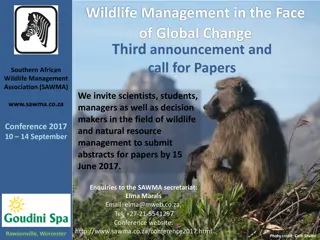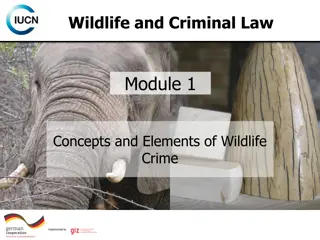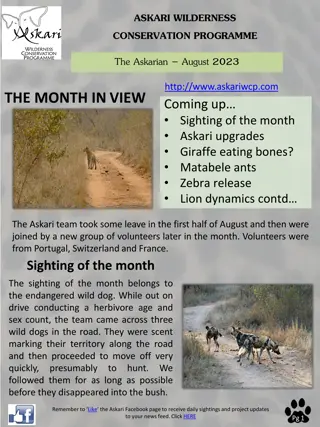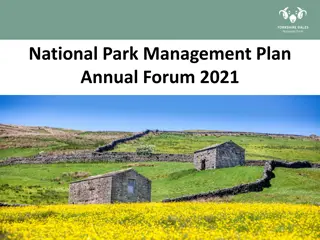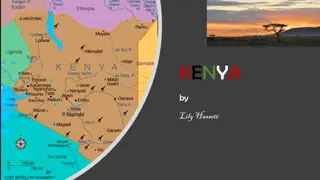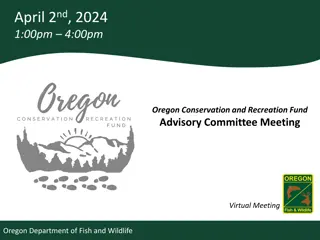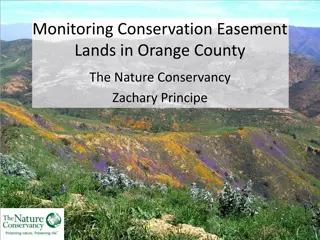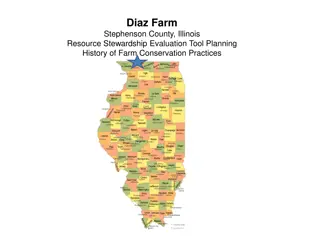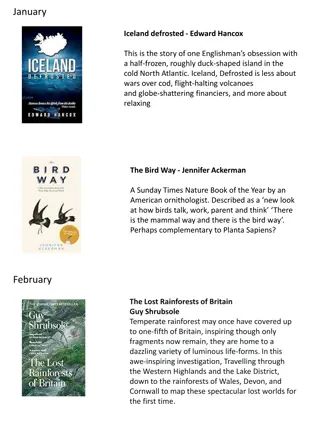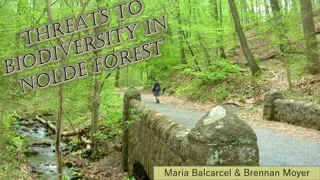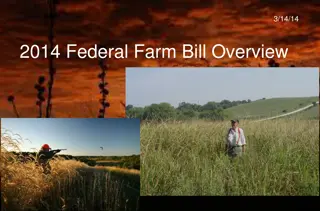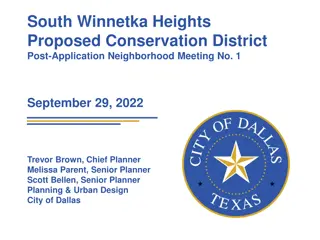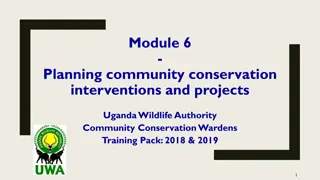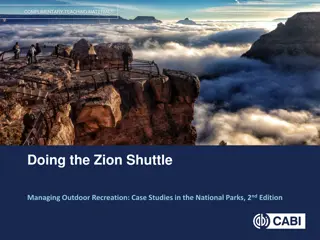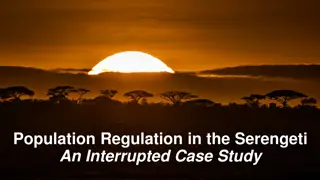Discover Gonarezhou National Park: A Haven for Wildlife and Conservation
Situated in Zimbabwe, Gonarezhou National Park is a vital conservation area protecting biodiversity and scenic landscapes. Home to a significant elephant population and iconic landmarks like the Chilojo Cliffs, the park plays a crucial role in the Greater Limpopo Transfrontier Conservation Area. Learn about its rich history, diverse ecosystems, and the efforts to ensure sustainability for future generations.
Download Presentation

Please find below an Image/Link to download the presentation.
The content on the website is provided AS IS for your information and personal use only. It may not be sold, licensed, or shared on other websites without obtaining consent from the author. Download presentation by click this link. If you encounter any issues during the download, it is possible that the publisher has removed the file from their server.
E N D
Presentation Transcript
ZEKEY MEDIA 1 GONAREZHOU NATIONAL PARK
The Gonarezhou Conservation Trust will protect and conserve the wilderness, biodiversity, ecological processes, wild and scenic landscapes within the park boundary. The park s exceptional resource values will be sustained for present and future generations, while supporting its role in the Great Limpopo Transfrontier Conservation Area and regional economic development. The culture and history of the Shangaan people will be recognised as one of the key components of the park. ZEKEY MEDIA 2
KUDU ZEKEY MDIA 3
The 5,035 km Gonarezhou National Park is the second largest national park in Zimbabwe, and plays host to a globally significant population of African elephant, currently numbering close to 11,000 animals. The protected area was established in 1934 as a Game Reserve and proclaimed as a national park in 1975. The park is situated within the relatively remote southeast-corner of Zimbabwe on the border with Mozambique, with which it shares a 100 km boundary. The Park forms an integral part of one of the largest conservation areas in the world the Greater Limpopo Transfrontier Park (GLTP established in 2002), which joins some of the most iconic national parks of Zimbabwe, Mozambique and South Africa in a conservation area covering some 35,000 km . GNP also plays an important part of the Greater Limpopo Transfrontier Conservation Area (GLTFCA) which incorporates national parks, private land and concessions, and communal areas in all three countries, spanning around 100,000 km . ZEKEY MEDIA 4
The landscape is scenic as a result of various sandstone incisions. The spectacular Chilojo Cliffs, at more than 180m high, lies at the heart of the Park and are a result of the river incision of the sandstones. Perennial and temporal pans are also a common feature. Apart from the two extensive pans near the Save/Runde junction (Tembwehata and Machaniwa) there are a number of larger pans which hold water well into the dry season. Steep rocky gorges with falls and rapids characterize sections of the Save, Runde and Mwenezi rivers. Noticeable peaks in the north are Makamandima (578m) and Mutandahwe (571m), with Nyamgtongwe (516m) in the center, and Red Hills in the south of the Park. The Save Runde junction is 165m above sea level and is the lowest point in Zimbabwe. ZEKEY MEDIA 5
The park experiences a short dry winter season in June and July with temperatures below 30C and a hot wet summer season from November to April when temperatures can exceed 40C. The remaining months are hot and dry. The mean annual rainfall is 466 mm but is highly variable. Two severe droughts have occurred since 1961 and the 1991/1992 drought led to the death of large numbers of wildlife. Mabalauta and Chipinda areas are open throughout the year. During the rainy season (November April), access to certain parts of the Park is restricted and the visitor should consult with the Park s offices before undertaking game drives. SEASONS BEAUTIFUL ZEKEY MEDIA 6
WOODLANDS ELEPHANTS Structurally the GNP is dominated by various types of woodland, ranging from alluvial woodlands, to mopane woodlands on heavier soils on basalts, igneous intrusive rocks and parts of the Malvernia Beds, plus various Guibourtia and Combretum dominated woodlands, principally on the sandier soils of the Malvernia Beds but also covering much of the northern granophyre. There are additional localized occurrences of miombo (Brachystegia spiciformis, B. tamarindoides subsp. torrei and Julbernardia globiflora), Androstachys and Spirostachys woodlands to closed woodlands, plus dry forest patches (on alluvium), thickets (on the Malvernia sands), bushlands (principally scrub mopane on basalts and Malvernia Beds) and wooded grasslands (mainly on the eastern granophyre portion). Natural grasslands are virtually absent, as are Acacia woodlands, whilst aquatic systems are limited to the three main rivers, the two artificial dams/weirs, plus numerous small and mostly seasonal pans. ZEKEY MEDIA 7
Floristically the area forms part of the Zambezian Regional Centre of Endemism (White, 1983), which includes all of Zimbabwe, Zambia and Malawi plus parts of Mozambique, South Africa, Botswana, Namibia, Angola, Democratic Republic of Congo and Tanzania. Fifty fish species have been recorded in Gonarezhou, primarily from the Save and Runde Rivers, but recent declines in water quality and flow patterns of the major rivers may have reduced this number. The killifish Nothobrancius fuzeri has historically been only found in pans of the Guluene/Chefu catchment, making it a Park endemic, but recent findings seem to suggest that its distribution also extends into the drainage system downstream into Mozambique. The Park remains it s type locality, and probably contains the core of it s range. Other noteworthy species include lungfish that occur in seasonal pans in the Guluene/Chefu catchment, and the Zambezi Shark and Small- tooth Sawfish, recorded at the Save/Runde confluence. ZEKEY MEDIA 8
The herpetofauna of Gonarezhou is unusual in Zimbabwe, as it includes many species which typically occur on the East African coastal plain. Reptiles and amphibians, being poikilothermic and less mobile than higher animal groups, are good indicators of bio- geographic boundaries, and their occurrence in Gonarezhou illustrates the bio-geographic importance of the Park. The Gonarezhou species list includes about 6% of the Southern African endemics and 14 species of special conservation interest. WILDLIFE AND HABITANTS 9
A total of 89 species of mammals in 71 genera and 31 families have been recorded from the Gonarezhou. A further 61 species, mostly insectivores or small rodents are likely to occur. Most of the work on mammals was carried out in the 1960 s and 1970 s and there is a need to re-evaluate some of the collections. The Yellow Golden Mole and Cape Hare are only known from Gonarezhou in Zimbabwe, and the red squirrel only occurs in the southeast Lowveld of the country. Latest estimates, (2016), for large mammals in the Park are: Elephant 10 715, impala 7 421, kudu 1 789, buffalo 4 797, zebra 1 830, nyala 187 (Gonarezhou is the only place in Zimbabwe where nyala are found in significant numbers), wildebeest 929, eland 241 and giraffe 446. The 2016 estimate of 10 715 elephants in Gonarezhou NP is only slightly below the peak estimate of 11 120 elephants during 2014, which was the highest estimate of the number of elephants in this park since sample surveys began there during 1975. ZEKEY MEDIA 10
WILDLIFE Gonarezhou has twice lost its black rhino population. Records indicate that the last of the original population had gone extinct by the early 1940s. A total of 77 black rhinos were released into the Park between 1969 and 1971, with the population building to more than 100 animals, but the species went locally extinct again due to poaching by the early 1990 s. ZEKEY MEDIA 11
LODGES Stay in the beautiful lodges in and around the park. Wake up to the sounds of the wilderness. Zekey media 12
ZEKEY MEDIA 13
